Maybe you’re dreaming up an AI chatbot who handles customer conversations like an expert support agent or an AI agent capable of managing complex business processes faster than a seasoned analyst.
With plenty of AI chatbot platforms available, choosing the right one for your conversational AI needs can be tricky.
Enter Botpress and IBM watsonx Assistant. Both are prominent AI platforms designed to streamline business operations, each offering unique strengths tailored for different business scenarios.
Wondering which fits your needs best? Dive into our comparison of Botpress and IBM watsonx.
Quick Overview: Botpress vs. IBM watsonx Assistant
TL;DR: IBM watsonx Assistant is great for secure, no-code customer service bots in enterprise settings. Botpress offers more flexibility and advanced features for building custom, autonomous agents.
IBM watsonx Assistant is a cloud-based platform by IBM for building AI chatbots and virtual assistants. It supports natural language understanding (NLU) and is designed for enterprises that need secure chatbots, especially in regulated industries. Watsonx Assistant supports some backend integration via IBM Cloud Functions and webhooks, but persistent memory and complex behavior require additional setup. It’s best suited for customer service automation in structured scenarios.
Botpress is designed for teams building intelligent, autonomous AI agents. It includes built-in memory, retrieval-augmented generation (RAG), JavaScript/TypeScript-based custom logic, and full control over conversation design. Botpress bots can make decisions and personalize responses across sessions – making them useful not just for customer service, but for sales, onboarding, internal automation workflows, and more.
Key Features of IBM watsonx Assistant
- Powerful NLP and deep learning capabilities
- watsonx Assistant for intuitive chatbot building
- Enterprise-ready integrations with IBM Cloud and Watson Discovery
- Advanced analytics and data-driven insights
- Highly secure platform with compliance and data residency features
- Customizable AI models with IBM's proprietary technology
- Integration with enterprise systems (Salesforce, SAP, Oracle)
- Extensive documentation, training, and enterprise-level support
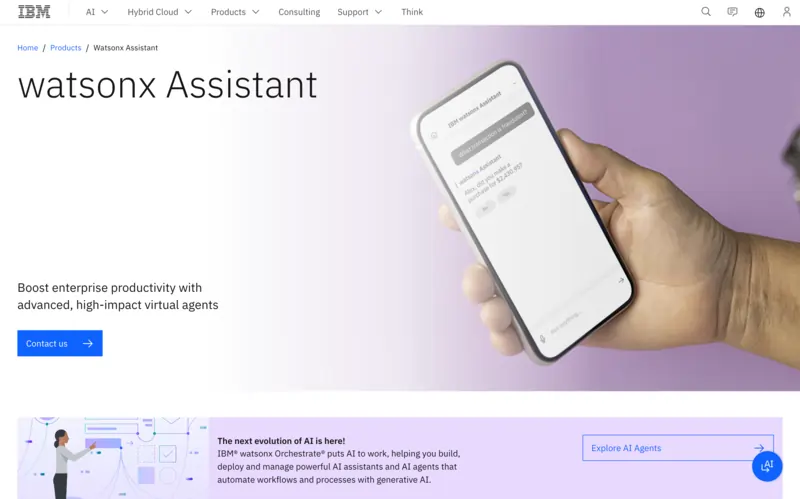
Key Features of Botpress
- Visual flow builder for complex conversation management
- Unlimited API integrations for extensive system connections
- Persistent memory for ongoing user context
- Support for custom code execution
- Choice of any large language models, including custom models
- Role-based access control (RBAC) and enterprise-grade security
- Advanced analytics and performance monitoring
- Active developer community (Discord community)
- Extensive educational resources (Botpress Academy)
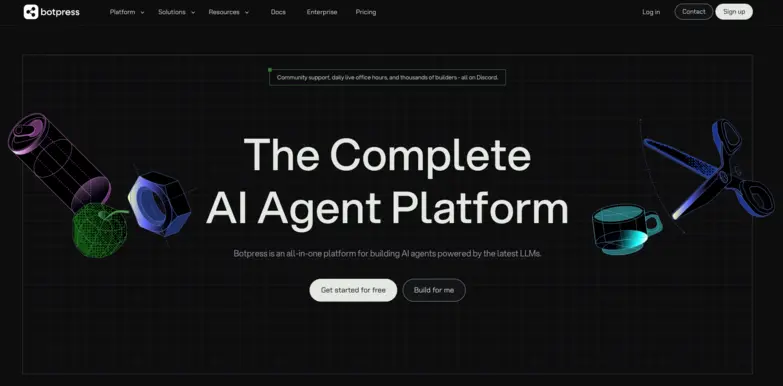
Feature-by-Feature Comparison
Botpress vs. IBM watsonx Assistant Pricing Comparison
IBM watsonx Assistant Pricing
IBM watsonx Assistant offers a free Lite plan designed for experimentation and small-scale use.
IBM also provides subscription-based paid tiers. Pricing is not available publicly but follows a tiered model depending on usage volume and features. Organizations must contact IBM for exact pricing.
Botpress Pricing
Botpress offers a free plan that includes $5 in monthly AI credits. These AI credits act as a budget for powering smart features like knowledge retrieval and text rewriting in your bots.
Botpress also offers a Pay-As-You-Go option, which lets teams pay only for the AI usage they consume, making Botpress a cost-effective option for businesses.
In terms of paid plans, Botpress offers straightforward pricing tiers:
Integration Capabilities
TL;DR: IBM watsonx Assistant supports key messaging and live-agent platforms through prebuilt connectors and webhook extensions, but is more limited in scope. Botpress offers 190+ integrations across platforms and makes it easy to build custom connections.
IBM watsonx Assistant offers 12+ built-in integrations for channels and tools like Slack, Microsoft Teams, Zendesk, Genesys, and Twilio (for WhatsApp), plus a web chat widget for websites. For custom workflows, developers can use webhooks or extensions to call external APIs via OpenAPI specs. This enables integration with systems like CRMs or ticketing tools, though setup often requires IBM Cloud Functions or custom backend logic. Compared to other platforms, watsonx Assistant has fewer plug-and-play integrations and lacks an open SDK for broader extensibility.
Botpress provides 190+ pre-built integrations across a wide range of tools like CRMs (e.g., Salesforce, HubSpot), help desks (e.g., Zendesk, Freshdesk), e-commerce platforms (e.g., Shopify, WooCommerce), databases, and messaging channels (e.g., WhatsApp, Messenger, Slack, web chat). In addition, Botpress supports custom API calls directly within the visual editor or using JavaScript/TypeScript nodes, making it easy to create powerful automations or connect with any third-party or internal system without external middleware.
Security Features
Community & Support
TL;DR: IBM watsonx Assistant provides structured, enterprise-style support, while Botpress delivers a more interactive, developer-centric support model.
Both IBM watsonx Assistant and Botpress provide structured resources like documentation, tutorials, and product guides.
IBM watsonx Assistant follows IBM’s enterprise-grade support model. Users can access learning materials via IBM’s Documentation Center and Developer Portal. For hands-on assistance, IBM offers tiered support through IBM Cloud Support Plans, which include options like ticket-based help and technical account management, though these are typically geared toward enterprise clients. Community support is available through IBM’s public forums and Stack Overflow, but engagement can be limited and not tailored to chatbot-specific challenges.
Botpress, by contrast, provides a more developer-friendly support ecosystem:
- Live chat support is available starting with the Plus plan.
- Max, Botpress’s AI assistant, helps troubleshoot and answer platform questions.
- Dedicated Customer Success Teams are included in Team and Enterprise tiers.
- A vibrant 30,000+ member Discord community offers peer support, live AMAs, and daily engagement with Botpress staff and power users.
Customization & Flexibility
TL;DR: Botpress gives teams full control over chatbot logic and system integrations. IBM watsonx Assistant supports basic customization and integrations, but advanced logic requires external setup.
IBM watsonx Assistant supports no-code flow building with options for integrating external APIs using OpenAPI specs and webhooks. For advanced backend logic, developers typically rely on IBM Cloud Functions or external services – the platform itself does not allow direct scripting or in-platform code execution.
While it supports conversation design and some pre-message and post-message processing, IBM watsonx flexibility is limited when it comes to dynamic logic or real-time computation. UI customization is available via its web chat plugin, but options are relatively basic.
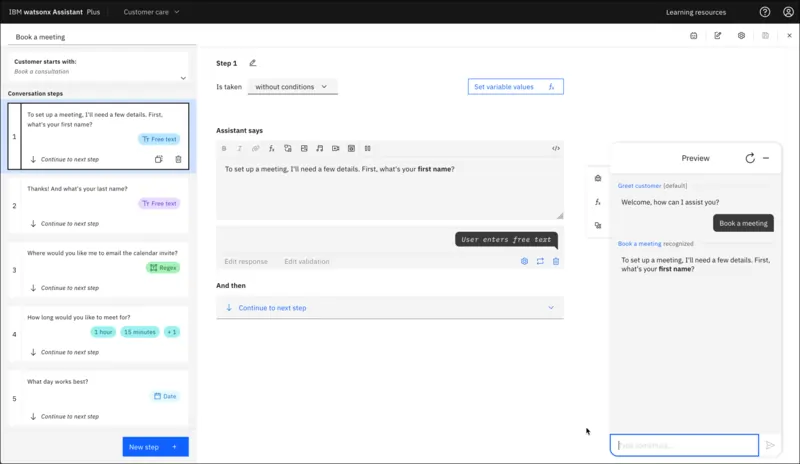
Botpress offers full-stack flexibility. Developers can write and run JavaScript or TypeScript directly in the platform, build reusable components, design advanced workflows, and fully control memory and context. Botpress bots can also adapt dynamically to inputs and business logic without needing external middleware. Its visual flow builder and modular architecture make it easy to scale, customize, and maintain complex bots across teams.
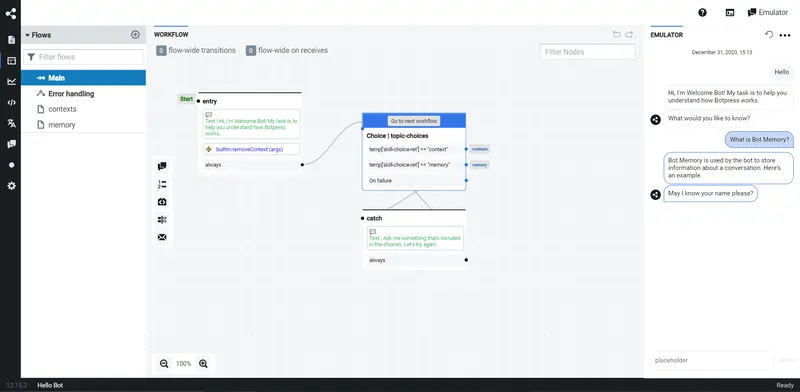
Memory Duration
TL;DR: IBM watsonx Assistant offers session-based context management but doesn’t include long-term memory by default. Botpress supports built-in memory across sessions for more personalized interactions.
IBM watsonx Assistant maintains context during a single session. However, once the session ends, memory is not retained. To persist user data between sessions, developers must set up external databases and configure the assistant to fetch or store that information using API calls or IBM Cloud Functions.
Botpress includes built-in memory that works across sessions. It can remember returning users and their preferences, allowing for personalized experiences over time. Developers have full control over what data is stored, how long it's kept, and how it's used, all within the platform.
Knowledge Capabilities
TL;DR: IBM watsonx Assistant offers basic knowledge integration using documents and FAQs. Botpress supports a much wider range of knowledge formats from APIs to PDFs for contextual automation.
IBM watsonx Assistant allows teams to upload structured knowledge documents (like FAQs and help content) which can be used to train the assistant’s responses. It also supports integrations with some enterprise knowledge bases such as Salesforce or Zendesk. For more dynamic data retrieval, developers can configure webhooks or use IBM Cloud Functions to call external APIs.
However, watsonx Assistant does not currently offer built-in support for retrieval-augmented generation, and its contextual response generation is more rules-driven than adaptive.
Botpress supports an advanced approach to knowledge access. In addition to importing static content like FAQs and documents, Botpress allows bots to connect to APIs, query databases, or parse structured and unstructured data such as JSON, CSVs, PDFs, or even web-scraped content.
Botpress’ in-house retrieval-augmented generation engine enables bots to extract the most relevant information at runtime, and generate contextualized responses based on retrieved content. This allows teams to build bots that don’t just recite static answers but adapt to varied user questions and contexts.
Which platform is better for my business?
1. 24/7 Multilingual Support for a Global Travel Company
Key Problem: Providing 24/7 multilingual support across channels for a global customer base.
TL;DR: IBM watsonx Assistant supports multilingual bots but lacks deep localization and channel flexibility. Botpress offers broader multilingual NLP and stronger channel integrations.
Amir leads customer support at a global travel booking platform. His team deals with time-sensitive inquiries like flight changes, cancellations, and travel advisories – often in multiple languages and across channels like WhatsApp, mobile apps, and the company website. Amir needs:
- A chatbot that can understand and respond in multiple languages
- Consistent experience across all platforms
- Ability to access real-time booking data and perform actions like cancellations or itinerary changes
IBM watsonx Assistant supports over 13 languages and includes a multilingual model option. Amir can deploy bots on web chat, Slack, and Microsoft Teams, and connect to other channels like WhatsApp using Twilio. For backend automation, IBM provides webhooks and cloud function integration. However, multilingual tuning is limited, and persistent memory or dynamic logic across languages requires external services and setup.
Botpress offers robust multilingual support (100+ languages), channel-agnostic deployment (web, WhatsApp, mobile, etc.), and flows that adapt based on user language or booking context. Built-in memory allows the bot to remember preferences between sessions, and backend integrations are straightforward. Botpress also offers flexible pricing and on-premise options, which makes it scalable and cost-effective for Amir’s growing global team.
For a global travel platform managing real-time, multilingual support across channels, Botpress offers more control and personalization.
2. Subscription SaaS Customer Support Scaling
Key Problem: A fast-growing SaaS company wants to deflect basic technical support and billing inquiries without hiring more agents.
TL;DR: IBM watsonx Assistant offers structured support for simple workflows. Botpress offers deeper integration and built-in memory for SaaS growth.
Sam is the Head of Support at a rapidly growing B2B SaaS company. His team handles a flood of tickets related to login issues, billing confusion, and onboarding questions. To keep up without hiring more agents, Sam needs:
- A chatbot that can answer repetitive technical and billing questions
- Easy deployment within Zendesk and Intercom workflows
- Backend integration with CRM and billing systems like Stripe or HubSpot
IBM watsonx Assistant provides basic integration options with support tools like Zendesk and Microsoft Teams, and limited API extension via OpenAPI. However, integrations with Stripe, HubSpot, or Intercom require manual setup or IBM Cloud Functions. Memory between sessions is not built-in, so personalization depends on connecting external systems to manage user history and context.
Botpress includes persistent memory and flexible backend integration. Sam can use JavaScript or TypeScript to create flows that fetch billing data, check subscription status, or automate onboarding inside helpdesk workflows. Botpress also supports tagging and escalation to human agents, making it a better fit for scaling support with automation and personalization.
In the scenario of a fast-moving SaaS company looking to automate support while retaining flexibility, Botpress provides a more personalizable solution.
3. Automated Order Management for a D2C E-commerce Brand
Key Problem: Automating post-purchase support like tracking, returns, and product questions.
TL;DR: IBM watsonx Assistant supports structured FAQs but requires external work for dynamic workflows. Botpress enables real-time automation with memory and product personalization.
Priya leads CX at a D2C e-commerce brand that just expanded internationally. Her team handles thousands of queries about order tracking, returns, and product details every week. Priya needs:
- A chatbot that can guide customers through returns and track orders in real time
- Seamless integration into Shopify and web chat
- Support for automating repetitive tasks like refund requests or FAQs
IBM watsonx Assistant can manage structured FAQ flows using intents and dialog nodes. It can connect to Shopify using custom webhooks or IBM Cloud Functions. However, there is no native integration with Shopify, and features like memory, complex workflow logic, or personalization across sessions require additional backend infrastructure.
Botpress can directly connect to Shopify APIs to fetch order data, guide users through returns, and automate refund requests. Its built-in memory lets the bot remember returning users and personalize product suggestions. Developers can build rich logic and conversational filtering for browsing large catalogs. Botpress’s pricing also supports growth through usage-based or fixed plans, ideal for Priya’s scaling needs.
For D2C teams handling high support volumes, Botpress provides greater automation and personalization to streamline post-purchase workflows.
4. Heavily Regulated Industry Support (e.g. Healthcare)
Key Problem: Automating inquiries while meeting strict compliance and audit needs.
TL;DR: IBM watsonx Assistant supports secure chatbot deployment but depends on IBM Cloud setup. Botpress offers more direct control with audit logs, on-premise deployment, and encrypted memory.
Marcus is responsible for customer experience at a healthcare provider. His team wants to automate scheduling, policy questions, and coverage info while staying compliant with HIPAA and regional data laws. Marcus needs:
- A secure chatbot that protects patient data
- Full audit logs and access control
- Option to deploy on-premise for compliance with internal security policies
IBM watsonx Assistant supports HIPAA-compliant deployments (with BAA) and benefits from IBM Cloud's enterprise-grade security. However, audit logs, access control, and deployment options must be managed through external IBM Cloud tooling. On-premise deployment is not directly supported, and persistent memory is not native.
Botpress, on the other hand, supports full audit logging, role-based access control (RBAC), encrypted memory, and offers on-premise or private cloud deployment. It allows Marcus’s team to build compliant workflows for appointment booking, coverage validation, or eligibility checks without exposing sensitive data to third-party services.
When it comes to regulated industries that need deployment control and built-in memory, Botpress is a better long-term fit.
The Bottom Line: Botpress vs IBM watsonx Assistant
IBM watsonx Assistant and Botpress are both powerful AI chatbot building platforms but they’re designed with different use cases and levels of flexibility in mind.
IBM watsonx Assistant is designed for enterprise teams that need secure, no-code chatbots, particularly in regulated industries. It’s ideal for automating structured support flows using predefined intents. However, advanced customization, memory handling, and real-time data access often require external tools like IBM Cloud Functions or webhooks.
Botpress is built for teams that want full control over their chatbot’s behavior and integrations. With built-in memory, workflow automation, and flexible pricing, Botpress is especially well-suited for companies scaling their support or building bots that go beyond basic Q&A.
FAQs
1. How does Botpress enable developers to create advanced workflows compared to IBM watsonx Assistant?
Botpress enables developers to create advanced workflows through its visual flow builder, built-in code editor (supporting JavaScript and TypeScript), and native support for persistent memory and conditional logic. Unlike IBM watsonx Assistant, which requires external tools like IBM Cloud Functions for custom behavior, Botpress allows in-platform scripting and modular components that can dynamically control conversation logic in real time.
2. Which chatbot platform provides better support for custom API integrations and real-time backend actions?
Botpress provides better support for custom API integrations and real-time backend actions by allowing developers to trigger API calls directly within the flow builder using code nodes. In contrast, IBM watsonx Assistant supports external API calls only through webhooks or IBM Cloud Functions, which adds complexity and limits in-platform execution.
3. Can I use Botpress or IBM watsonx Assistant to power internal workflows like IT support or HR automation?
Yes, both Botpress and IBM watsonx Assistant can power internal workflows but Botpress offers more flexibility and easier backend integration. With features like in-platform code execution, persistent memory, and multi-step logic, Botpress allows for more complex workflows that can interact with internal systems directly, whereas IBM watsonx requires more setup and external services for similar functionality.
4. Which platform offers better flexibility for building multi-function agents over time?
Botpress offers better flexibility for building multi-function agents over time due to its modular architecture, reusable components, and support for logic branching, memory, and custom code. It allows agents to evolve across use cases (e.g., from customer service to sales to onboarding) without needing to rebuild or rely on external orchestration layers, unlike IBM watsonx Assistant, which is more rigid and flow-based.
5. If I’m building a chatbot with long-term memory or persistent user context, which platform is better?
If you’re building a chatbot with long-term memory or persistent user context, Botpress is the better choice. IBM watsonx Assistant only maintains session-based context and requires external databases and configuration to simulate long-term memory.
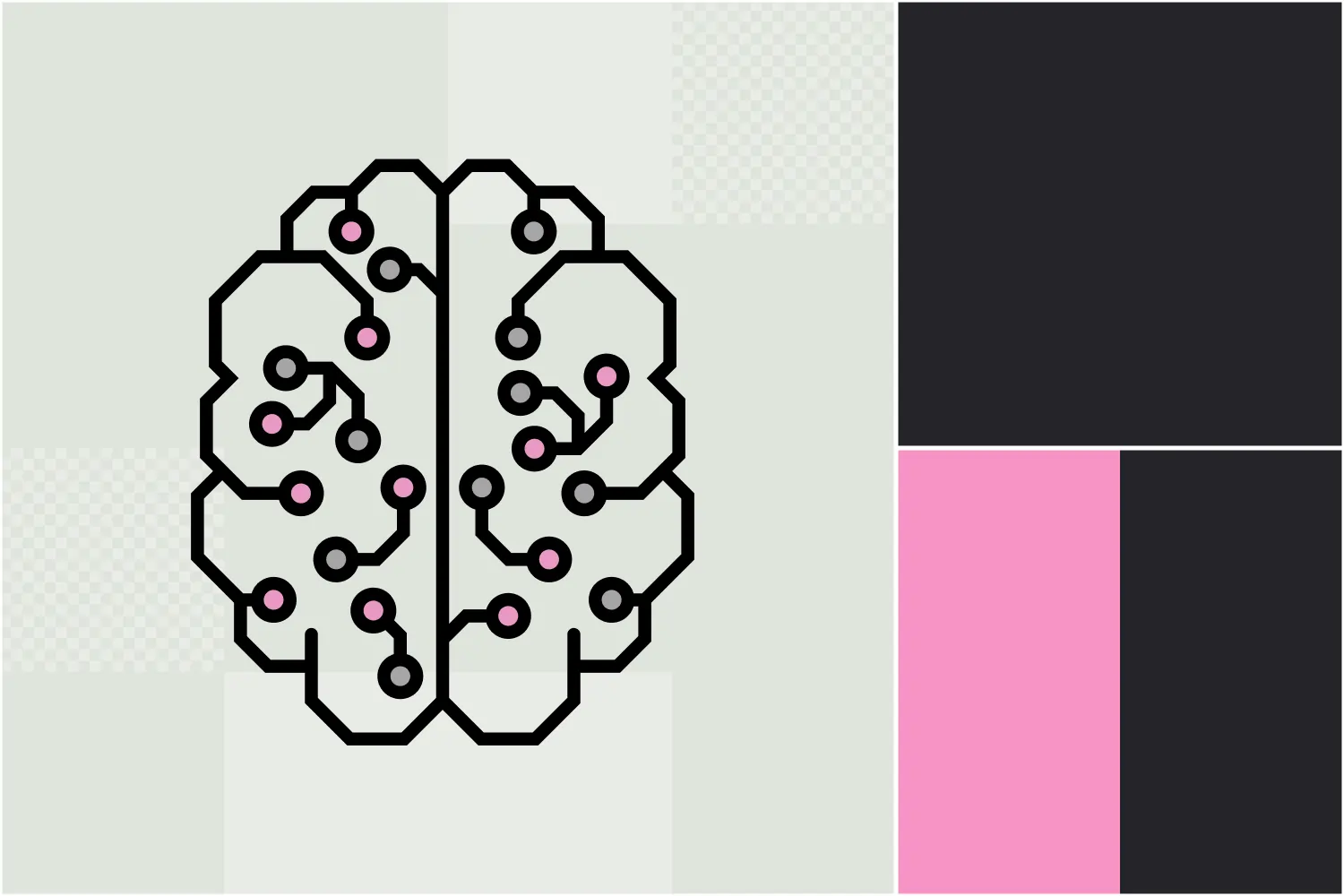




.webp)

